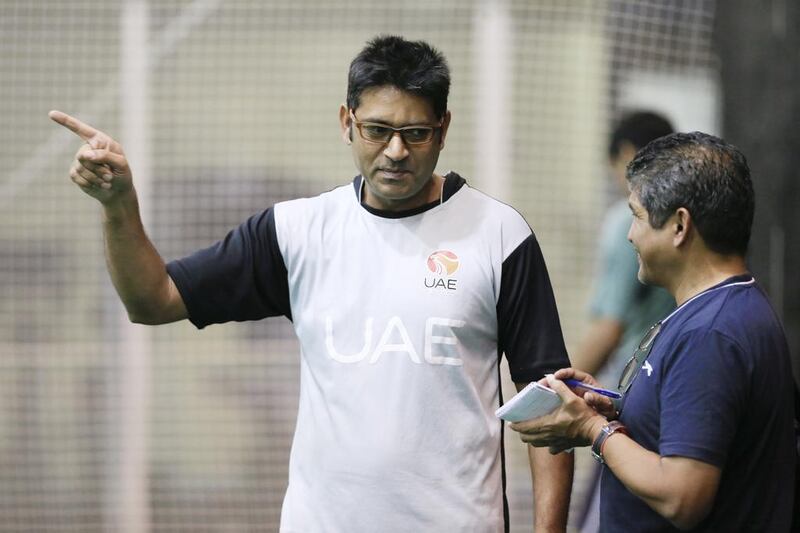The Test-playing nations began playing matches in readiness for the upcoming Under 19 World Cup months ago.
Yet the UAE, the hosts, have not played a competitive game since May, when they finished runners-up to Afghanistan in the Asia Cricket Council U19 Elite Cup in Malaysia.
However, it is not a fact that worries Aaqib Javed, the UAE coach, who was a member of the Pakistan team in the inaugural U19 World Cup in 1988.
Javed presented “a pathway” to the Emirates Cricket Board (ECB) last season that included an U19 competition between Abu Dhabi, Dubai, Sharjah and select XI comprised from the other four emirates.
It did not materialise, but Aaqib is satisfied with what his team have been doing from the beginning of the new season.
“We will increase the training and play a lot of matches in the coming months, he said.
“It will not be as good as training five to six days a week, but good enough.”
Aaqib’s biggest problem is getting the players together for training.
The U19 squad members have to attend school while the senior squad have to attend practice after their day jobs.
“I have a lot of sympathy with the players, both in the age group as well as the senior national team. Some of them have to travel from as far as Abu Dhabi and Ajman to train in Dubai,” he said.
The UAE will play a tri-series friendly when Pakistan’s U19s host their home series in the Emirates, which also includes England, from December 1 to 22, playing three matches each.
Next up for the UAE is the Asia Cup U19 in the Emirates, from December 26 to January 4, in which they face India, Pakistan, and Nepal in Group A.
They are drawn alongside England, New Zealand and Sri Lanka in the U19 World Cup in February.
The UAE age-group team began training twice a week at the ICC Global Cricket Academy (GCA) in Dubai in September.
The plan is to increase the sessions to four in November, including a game every Saturday at Al Dhaid in Sharjah between the shortlisted 30 players.
At the GCA indoor facility, the youngsters go through the paces under Aaqib and his team, which include Colin Wells (batting coach), Mohammed Hyder (bowling), Shaharzade Saleem (fielding), Chitrala Sudhaker (physiotherapist and trainer), and Shah Hussain (video analyst).
“The batsmen get one hour of batting on three different surfaces – fast and bouncy, spin, and batsmen-friendly wickets – and the bowlers get one hour of bowling on the respective surfaces,” Aaqib said.
“Everyone here in my team has got a responsibility and the boys will have to go through the drills we have planned in all areas, both physically and mentally.
“The work we do is also related to improving their fitness and technical skills.
“Both the technical staff and the players go through all the drills in the two hours.”
Aaqib, who is a fitness fanatic and never misses his daily workout and a 1km swim, still bowls at a snarling pace and accuracy throughout the two hours, providing the youngsters a test of what to expect when they compete at the world stage.
He and Hussain developed a sidearm bowling technique, involving a run-up, providing the batsmen with quick, accurate swinging and seaming deliveries.
“This is the ultimate in fast bowling on a pacey and bouncy surface,” Aaqib said.
“The sidearm [technique] is normally used from a standing position from the crease, but we did some research to [adapt] this technique so that we can run and bowl as with a normal fast-bowling delivery.
“It is not easy to do this, but Shah bowls non-stop for two hours.
“This is the type of commitment and dedication the coaches have to work on the players.”
Aaqib, who has been the coach of Pakistan’s age-group teams and was later the bowling coach of the senior national team, has previously developed different coaching tools, which have helped several fast bowlers in the country.
He placed giant mirrors behind the batsman’s wicket so he could watch his run up until the point of delivery.
The other idea involved placing a temporary corridor, four feet in width and six feet in height, at the bowling end, to straighten a bowler’s run up.
“It takes a lot of passion and efforts to do it,” said Aaqib, who played 22 Tests and 164 ODIs for Pakistan in an international playing career spanning for nearly a decade.
“When a bowler runs up to bowl, he can see for himself the right and the wrong [of his action]. It will help him to correct himself. In my opinion, it is very effective.”
According to Aaqib, several bowlers in the Pakistan team have benefited from the exercise.
“I work on the strengths of the player than their weaknesses,” he said. “I work 80 per cent on their strength and 20 per cent on their weakness.
“It helps them more by making them stronger in what they are good at, instead of working on their weaknesses that take more time.”
apassela@thenational.ae
Follow us on twitter at @SprtNationalUAE






